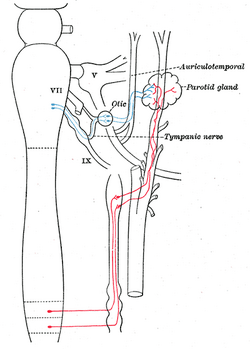
The inferior salivatory nucleus is one of the components of the glossopharyngeal nerve, which stimulates secretion from the parotid gland.
In the brain, the inferior salivatory nucleus is a cluster of neurons controlling the parasympathetic input to the parotid gland. It is one of the components of the glossopharyngeal nerve (cranial nerve IX).
Location[]
Its precise location in humans has not yet been identified, but in other mammals it is located in the medulla within the general visceral efferent cell column, superior to the nucleus ambiguus and inferior to the superior salivatory nucleus.
Pathway[]
While still in the medulla, fibers of the inferior salivatory nucleus join with fibers of the gustatory nucleus, nucleus ambiguus, and spinal nucleus of the trigeminal nerve, and exit the medulla as the mixed glossopharyngeal nerve (cranial nerve IX). It sends fibers through the glossopharyngeal nerve's tympanic nerve and into the tympanic plexus. Exiting the plexus within the lesser petrosal nerve, these preganglionic fibers synapse with cells in the otic ganglion, which send postganglionic fibers into the mandibular division of the trigeminal nerve, then into the auriculotemporal nerve, finally reaching their target, the parotid gland.
Function[]
Parasympathetic input from fibers of the inferior salivatory nucleus stimulates the parotid gland to vasodilate and secrete saliva.
Assessment |
Biopsychology |
Comparative |
Cognitive |
Developmental |
Language |
Individual differences |
Personality |
Philosophy |
Social |
Methods |
Statistics |
Clinical |
Educational |
Industrial |
Professional items |
World psychology |
Biological: Behavioural genetics · Evolutionary psychology · Neuroanatomy · Neurochemistry · Neuroendocrinology · Neuroscience · Psychoneuroimmunology · Physiological Psychology · Psychopharmacology (Index, Outline)
See also[]
References[]
- Kiernan, John A. (2005). Barr's The Human Nervous System: An Anatomical Viewpoint, 150, Lippincott Williams & Wilkins. ISBN 0-7817-5154-3.
| This page uses Creative Commons Licensed content from Wikipedia (view authors). |